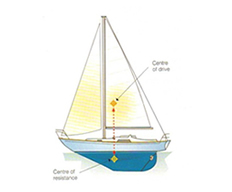
Sail trim is all balancing act
As soon as the sail plan changes, so does the handling. Balancing the sail set correctly will allow the yacht to sail with little requirement of the rudder.
In an ideal world when the wind is hitting each sail with the same force, the sails should steer the boat and the rudder merely guide it along its path. Going upwind and when the sails are balanced the rudder should feel light and have just a small tendency to head up into the wind. If the rudder is pulling hard one way or the other to stay on course the sail balance is probably incorrect and the excess rudder is slowing the boat.
If the rudder is pulling hard one way or the other to stay on course the sail balance is probably incorrect and the excess rudder is slowing the boat.
How yachts pivot. Achieving the balance
Yachts pivot under sail. How they pivot depends on the relationship between the sail area above the waterline and that of the underwater profile of the boat. The central point of the underwater area is known as the centre of lateral resistance (CLR) and this is the pivot point. It is often just aft of the mast.
The forces produced by the wind on the sails are focused to a mid-point in the sail plan, the centre of drive (CD).
Depending on the sail set, pressure on the sails will either balance or rotate the boat around this pivot point (CLR). When the sails are balanced, the CD is in line with the pivot point allowing the yacht to sail straight with little requirement of the rudder.

The balance is changed by too much pressure in one of the sails either when the wind increases, when reefed or when the boat is sailing with just main or genoa.
Main sail pressure
When sailing with too much mainsail or just the main the CD moves behind the pivot point causing the boat to head up into the wind. This explains why it is hard to bear away with the main pinned in hard; the only solution is to ease the main before bearing away.
If sailing with just a mainsail or too much mainsail, to counteract the pivoting effect of the sail and sail a straight course, the tiller or wheel is steered to weather giving weather helm, slowing the boat.
Genoa pressure
When sailing with just a genoa, the CD moves in front of the pivot point, pulling the bow downwind. To counteract this tendency the tiller is pushed to leeward giving lee helm, slowing the boat.
However, a large overlapping genoa, with sail area coming behind the pivot point will start to act like a mainsail as the overlap is helping turn the bow into the wind.
Boat heel and pivot point
When a boat heels to leeward, the sail plan and CD moves to leeward of the pivot point. Because the sail plan is driving forward it is also rotating around the pivot point and makes the boat turn into the wind.
Conversely, if windward heel is induced, the boat turns to leeward as the CD moves around the pivot point.
So as the boat heels to leeward, weather helm increases from both sail pressure and the CD moving to leeward of the pivot point below.
Listen to the boat…
If the boat is trying to turn into the wind try;
- De-powering the mainsail using the traveler, sheet or reefing.
- Reducing leeward heel
- Reefing the genoa if is a large overlapping type
- Increasing the genoa – so long as this does not make you heel more.
If the boat is turning away from the wind;
- Reduce the genoa, ease the sheet
- Increase the mainsail
- Ensure you are not heeling to windward
As soon as the sail plan changes, so does the handling - so listen to what your boat is telling you… Sail the boat without excessive heel and keep the sail plan balanced as you reef.
By Simon Jinks, RYA Yachtmaster™ Instructor Examiner and Journalist.
Contact UsArticle Published: March 31, 2011 14:51
Article Updated: April 30, 2013 13:31